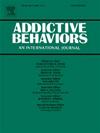Antisocial and prosocial behaviors as predictors of subsequent substance use in adolescence
IF 3.7
2区 医学
Q1 PSYCHOLOGY, CLINICAL
引用次数: 0
Abstract
Background
Antisocial behavior is a known risk factor for substance use in adolescence, but the combined effects of antisocial and prosocial behaviors are unknown. This study examined whether five types of anti- and prosocial behaviors are associated with subsequent alcohol and substance use.
Methods
A prospective longitudinal cohort study of 3817 adolescents (55.3% females) aged 15 at baseline (T1) and 17 at follow-up (T2). Self-reports at T1 measured antisocial behaviors (criminal behavior, conduct problems) and prosocial behaviors (global prosociality, general trust, institutional trust). T2 measures included alcohol use (hazardous use, alcohol use disorder), drug use, and nicotine use.
Results
Antisocial behaviors positively predicted all types of substance use (X2 = 5.79 to 59.07, p < 0.001), while prosocial behaviors negatively predicted most substance use measures (X2 = -5.64 to 86.14, p = 0.862 to < 0.001). After adjusting for covariance between antisociality and prosociality, it was found that conduct problems (X2 = 5.54 to 32.22, p = 0.005 to < 0.001), criminal behavior (X2 = 3.61 to 33.77, p = 0.007 to < 0.001), and institutional trust (X2 = -3.92 to 27.56, p = 0.262 to < 0.001), were the most important predictors.
Conclusions
Antisocial behaviors and deficits in institutional trust at age 15 are strong and unique predictors of substance use and alcohol use disorder by age 17. This specific spectrum of social behaviors during the critical phase of adolescence is of relevance from a prevention perspective to minimize the risk of later development of substance abuse.
反社会和亲社会行为作为青少年后续物质使用的预测因子
反社会行为是青少年药物使用的已知危险因素,但反社会行为和亲社会行为的综合影响尚不清楚。这项研究调查了五种类型的反社会和亲社会行为是否与随后的酒精和物质使用有关。方法对3817名15岁(T1)和17岁(T2)青少年进行前瞻性纵向队列研究,其中女性占55.3%。T1的自我报告测量反社会行为(犯罪行为、行为问题)和亲社会行为(整体亲社会性、一般信任、机构信任)。T2测量包括酒精使用(危险使用、酒精使用障碍)、药物使用和尼古丁使用。结果反社会行为正向预测各类物质使用(X2 = 5.79 ~ 59.07, p <;0.001),亲社会行为负向预测大多数物质使用措施(X2 = -5.64 ~ 86.14, p = 0.862 ~ <;0.001)。在调整反社会性与亲社会性的协方差后,发现行为问题(X2 = 5.54 ~ 32.22, p = 0.005 ~ <;0.001),犯罪行为(X2 = 3.61 ~ 33.77, p = 0.007 ~ <;0.001),机构信任(X2 = -3.92 ~ 27.56, p = 0.262 ~ <;0.001),是最重要的预测因子。结论15岁时的社会行为和机构信任缺陷是17岁时物质使用和酒精使用障碍的强大和独特的预测因子。从预防的角度来看,青春期关键阶段的这种特定的社会行为范围与减少药物滥用的风险有关。
本文章由计算机程序翻译,如有差异,请以英文原文为准。
求助全文
约1分钟内获得全文
求助全文
来源期刊

Addictive behaviors
医学-药物滥用
CiteScore
8.40
自引率
4.50%
发文量
283
审稿时长
46 days
期刊介绍:
Addictive Behaviors is an international peer-reviewed journal publishing high quality human research on addictive behaviors and disorders since 1975. The journal accepts submissions of full-length papers and short communications on substance-related addictions such as the abuse of alcohol, drugs and nicotine, and behavioral addictions involving gambling and technology. We primarily publish behavioral and psychosocial research but our articles span the fields of psychology, sociology, psychiatry, epidemiology, social policy, medicine, pharmacology and neuroscience. While theoretical orientations are diverse, the emphasis of the journal is primarily empirical. That is, sound experimental design combined with valid, reliable assessment and evaluation procedures are a requisite for acceptance. However, innovative and empirically oriented case studies that might encourage new lines of inquiry are accepted as well. Studies that clearly contribute to current knowledge of etiology, prevention, social policy or treatment are given priority. Scholarly commentaries on topical issues, systematic reviews, and mini reviews are encouraged. We especially welcome multimedia papers that incorporate video or audio components to better display methodology or findings.
Studies can also be submitted to Addictive Behaviors? companion title, the open access journal Addictive Behaviors Reports, which has a particular interest in ''non-traditional'', innovative and empirically-oriented research such as negative/null data papers, replication studies, case reports on novel treatments, and cross-cultural research.
 求助内容:
求助内容: 应助结果提醒方式:
应助结果提醒方式:


